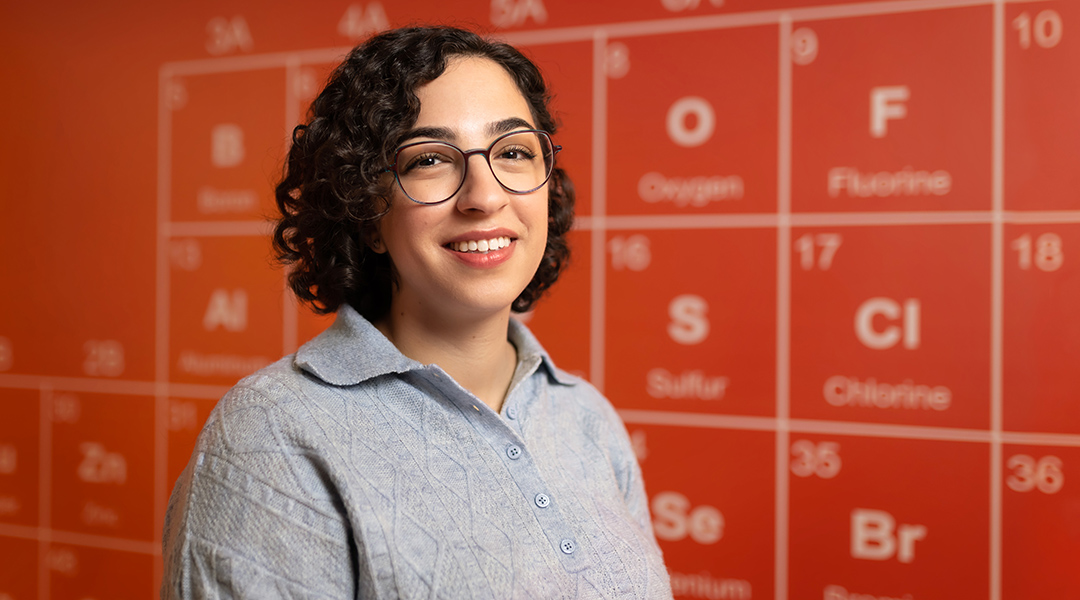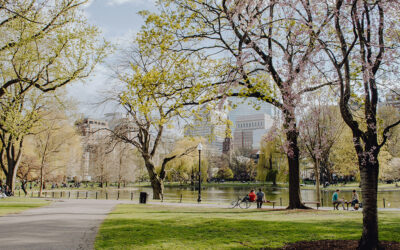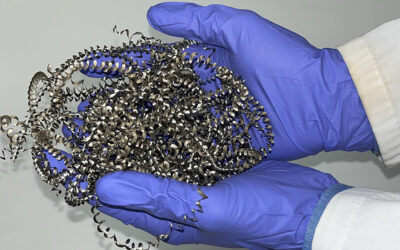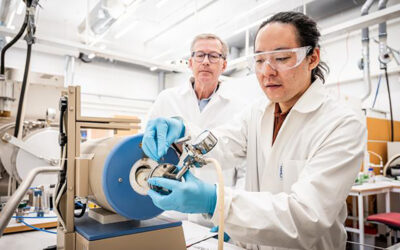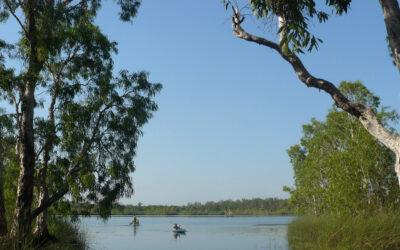Environmental chemistry is at the forefront of addressing today’s most pressing ecological challenges, with researchers leveraging foundational science to address real-world problems. Shira Joudan’s work epitomizes this drive to make a difference.
Joudan, an environmental and analytical chemist, is investigating how reactions affect the environmental fate of organic contaminants, such as per- and polyfluoroalkyl substances (PFAS). These compounds have gained public attention recently due to their resistance to degradation and persistence in the environment.
“I sometimes joke that as an undergraduate student I knew I liked organic molecules, but I didn’t want to be a synthetic chemist,” she wrote in an essay titled My Pandemic Postdoc. “I also enjoyed analytical chemistry and so the idea of using that to study the environment matched up well with my love of the outdoors.”
Last year, Joudan took up the position of assistant professor at the University of Alberta, sharing her experiences setting up a new lab, teaching for the first time, and highlighting the importance of building a supportive community to navigate these daunting tasks.
Her open and positive attitude have no doubt contributed to her success, where she’s cultivated an approachability that makes conversation easy and any questions welcome. It feels like it’s not just about the research for Joudan.
In our interview, she shared insights into her work on environmental contaminants, her experience establishing herself at a new university, and the significance of building diverse relationships throughout the process.
What was it like to set up a new lab from scratch? What were your feelings around it?
I was really excited. I’d had a little time to mentally prepare because I had about a year between the time I got hired and the time I actually started. But it was crazy. I felt like I had no idea what was going on — not that I had no idea what I was doing in terms of, you know, science or mentorship, more like, who do I ask about buying a fridge? How the financial accounts at a university work?
The first month or two I felt like I was buzzing the whole time. Just feeling the pressure and excitement and that overstimulation, but it eventually settled down.
What was the best advice you got?
I think simply just to ask questions. Instead of being confused for two days, could I either e-mail someone or walk down the hall and say, how do you do this? Like, can you show me how you log into this portal? That’s just an example, but if I was doing it alone, it could take me hours, so I think the best advice is, ask questions and ask for help.
Your lab’s research centers around environmental chemistry, in particular PFAS. Can you explain what these are and about the work that your lab does?
I’m really interested in how human-made contaminants exist in the environment, how they’re transported, how chemical reactions can impact what happens to them, and how humans and ecosystems are exposed to them.
PFAS (per- and polyfluoroalkyl substances) are a very large class of anthropogenic contaminants that are structurally similar by having carbon-fluorine bonds. They have really useful properties that we used for years, but there’s a lot of problems with some PFAS, like toxicity and bioaccumulation, and many of them just don’t break down in the environment in a geological time scale.
Because of all these concerns, there are moves to ban them or phase them out of production. And the way I fit into this, as an environmental chemist, is understanding, from a molecular perspective, how PFAS react (for those that do) and how they are transported. In practice, that looks a lot like simulating the environment in a lab experiments, whether that’s an oxidation experiment or biotransformation experiment and determining that certain PFAS react to form other PFAS. Or, we measure them in the environment to try to understand trends of usage or how they’re transported from, say, a city to a remote region.
What got you into this area of research?
Thinking back to undergrad, I always knew I liked the environment and then taking all the chemistry courses — I liked my analytical courses, making measurements, I thought mass spec was so cool, and I also liked my organic chemistry classes — I realized I didn’t want to make chemicals, I wanted to study them in the environment. The sorts of questions you can ask and the combination of chemistry knowledge you need to answer these questions is really interesting to me.
Then for PFAS, specifically, I mean, they’re just such a big issue in the world right now. And so once I got into this work, which was 11 years ago, I saw how many questions remained. The intersection of my interests and the need for chemists to help answer some of these questions inspired me to continue studying PFAS.
Why are PFAS important to study in the environment? They’re a trending topic at the moment, you see so many articles with sensational headlines, but is there nuance they’re not capturing?
I think it’s really a tough thing to balance because I’ve seen a lot of fear mongering even on TikTok where it’s some 17-year-old being like, “Forever chemicals are killing you!” While I’m happy people are engaged, I do worry about unnecessary fear mongering.
There are thousands of PFAS and while there’s debate on how to define if a molecule is a PFAS or not, we know for sure, without a doubt, that certain PFAS are toxic and some are quite bioaccumulative, which means they build up in humans or other species and can have a more harmful effect.
I am more concerned for those who receive high exposures of PFAS, such as those living near chemical manufacturing plants or army bases. For the rest of the population, who are exposed to low concentrations of PFAS over time, we don’t have enough information at this point to know whether there will be any long-term impacts.
In the environmental chemistry research of PFAS, since many PFAS don’t degrade in the environment, they’re going to be there for hundreds of years, so we need to understand how they behave to support managing this continuing problem. The idea is, if they don’t break down and we keep using them, they’re going to be keep building up — and they are currently contaminating the entire globe, even where people don’t really live or where people live who don’t benefit from their use.
This is a long-term problem, even if we stopped PFAS today. Finally, I will add that when trying to make regulatory decisions, there can be a lot of tension between those who want PFAS banned and those who seek to make money off them. So having more information that can trace where specific PFAS are coming from is also really important to support regulatory action.
Is there anything people can do to minimize their exposure?
I now get my friends frantically texting me to ask these questions, which is not something I expected would happen 10 years ago.
For the average person trying to minimize exposure that they can control, there are certain steps we can take and there’s a website of companies who have committed to not using PFAS, such as some outdoor clothing companies. I did just send that link to my friend recently to make informed decisions because I think people feel empowered when they have information.
Another friend has emailed a company directly to ask if they have PFAS in their products — an additional benefit to that is showing companies what their customers prioritize. But it’s hard because we can’t control our overall exposures, like from drinking water and food. We can’t always know what we are being exposed to.
I think the way forward is to protect our entire community and take it out of the hands of the average person, who most likely can’t control most of their exposure, and if they can, require significant resources to figure out how. It’s an equity issue.
What do you see as the most pressing challenge in your field? Is it PFAS or another issue we should be paying attention to?
I think one of the biggest challenges for environmental chemistry in general is that there are so many chemical contaminants in the environment, but only a very small fraction cause the harmful effects that we see.
Most of them, they’re not toxic, so for the community to find out which ones exist in the environment and are causing problems so we can prioritize our research. We can’t do experiments on millions of compounds. It’s just not feasible.
You wrote an article titled The joys and challenges of teaching for the first time. Can you provide a snapshot of your experience teaching for the first time?
In the article, I wrote about starting to teach as a professor, and I think the biggest thing for new professors is it’s just so much work.
Getting into the new rhythm of teaching is one thing I would say, and dealing with student emails, which was a big learning curve for me. Some things I liked about teaching this year were there were some fundamental science concepts that I probably forgot about because I don’t think about them all the time. That actually helped me in my research and helped me ask those hard questions during Ph.D. candidacy exams!
I like to interact with students too. As a grad student, you kind of show up, do the hectic lab you are a teaching assistant for, and then go back to your own research. As a postdoc, I just went in and did research and it was also during the COVID pandemic. I was almost living in my own world and I found that once I started teaching again, I felt like I was back into the heart of the university.
Now, when I walk around, I know people, and some undergrads are really excited to have a new professor. I’m the youngest person they may see in this role, and even though generationally we are very different, I think they’re happy to see someone who’s new to their job and excited to be there. And I do try to convey that.
You also wrote about the importance of community in your journey as a new professor. Could you tell us more about that?
I think I mentioned a bit earlier how at the beginning I had no idea what I was doing. The job can be a bit unique because of all the different hats we have to wear and some of the expectations, especially pre-tenure. I’ve really found that having different kinds of people in my corner for different needs has been helpful.
For example, when dealing with a student who is having challenges, whether in my class or a grad student or something, talking to professors who have a lot of experience with that usually just makes me feel better. They’re like, it’ll be fine and then they give some advice.
Or if someone else is writing the same really difficult grant as me, even just talking about it can be helpful. It can be asking for advice, it can be commiserating, or it can be kind of like bouncing ideas off each other. And if I’m really excited about something and want to celebrate, my parents or friends who aren’t in the field might not get it.
I think that having people who get the super, super niche thing you’re going through is so helpful because you don’t have to give a background explainer. It’s probably not unique to academia, but it can be really helpful.
Do you feel this element of community comes easy within academia, where the environment is often hyper competitive? Is it unique to the school or something you actively sought out?
Yeah, such a great point. Often it’s framed in academia that we are all independent. We have to do things ourselves, and we’re being ranked. But, I mean at least where I’m working now, I’ve found that people are quite supportive, even just asking quick science question to a colleague. I think I also put a lot of effort into this.
I do feel that sometimes it can be competitive, but I try to tell myself that’s not how I want to live my life with this job. I think part of it is me, my personality, but a part of it is just trying to be comfortable with the fact that even if even if we live in a competitive world for this job, I don’t want to contribute to creating battles.
Is it something you try to foster in your own lab?
Even when we try to be supportive, there’s still going to be differences like students who get competitive scholarships, or whose papers are published in more elite journals. Those are built into academia. But for my group now, I do try to make it a teamwork type community, but it is hard to force things onto people. They do need to kind of happen organically, but still be led through me.
I try to tell my students that if they need help with something, to please ask each other. Part of being in a lab or a group is that you help each other. It’s still an evolving process to build our lab group culture that I hope will progress in the right direction over the next few years.
What is one thing on your bucket list that you haven’t done yet?
Travel to Patagonia!
If you could have dinner with any historical figure, who would it be and why?
Probably family members I never got to meet to hear more about my family history.
What do you like to do outside the lab?
Hang out with friends and get outside.
If you could travel anywhere in the world right now, where would you go?
I’m actually in Seville right now for a conference but would like to go visit my little nephew!
This interview transcript was edited for flow and clarity

